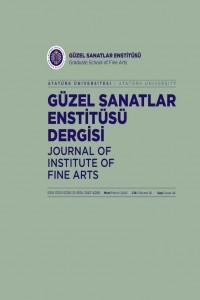Güzel Sanatlar Fakülteleri Seramik ve Cam Bölümlerinde Kullanılan Seramik Fiber Bazlı Malzemelerin Kanserojen Etkileri ve Yüksek Sıcaklık Cam Fiberler
Ülkemizde yaklaşık seksen yıldır Güzel Sanatlar Fakülteleri bünyesinde bulunan Seramik ve yirmi yıldır da Cam Bölüm/Atölyelerinde aktif olarak öğrenci eğitilmektedir. Bu bölümlerin özellikle fırın ve izolasyon alanlarında kısmen de üretilen işlerde yardımcı malzeme olarak seramik fiber malzemeler kullanılmaktadır. Araştırma, meslek yaşamları boyunca bu malzeme ile kontakta bulunan ve bulunacak olan gerek öğretim elemanlarını ve gerekse öğrencileri bilgilendirmeyi amaçlamaktadır. Bu tür malzemeler ile temasa geçen kişiler muhakkak solunum yollarını korumalı ve eldiven kullanmalıdır. Alternatif olarak geliştirilen zararsız Yüksek Sıcaklık Cam Fiber malzeme ise yüksek maliyeti ve düşük teknik özellikleri nedeniyle henüz yaygın biçimde kullanılmamaktadır. Araştırmada Betimsel Yöntem kullanılmıştır. Alan yazın taranarak, konu hakkında Avrupa Birliği teknik şartnameleri incelenmiş, kitap, dergi, elektronik kaynaklar taranarak bir durum tespiti yapılmaya çalışılmıştır. Araştırmanın sonucunda, fiber malzemeler ile yalnızca eğitimleri sırasında birkaç defa kontağa girecek öğrencilerin sadece nefes yollarını korumalarının yeterli olduğu; bu maddelerle sürekli kontakta olan, seramik ve cam eğitimi veren öğretim elemanlarının ise kendilerini korumalarının yanı sıra, bulundukları ortamın da fiber partikül sayısının aralıklarla kontrol edilmesi gerektiği tespit edilmiştir.
Anahtar Kelimeler:
Seramik Fiber, Kanserojen etki, Yüksek Sıcaklık Cam Fiber
The Carcinogenic Effects of Ceramic Fiber Based Materials Used in Ceramics and Glass Departments of Fine Arts Faculties and High Temperature Glass Fibers
Within the Faculty of Fine Arts in our country, , for nearly eighty years Ceramic Departments and for twenty years the Glass Department and Ateliers have actively educated students. In these departments, ceramic fiber materials are used especially for kilns and isolation are a sand in partially used as an auxiliary material for the art work. The aim of this article is to inform both academics and students who contacts and will be contacted with this material for a life long time. People in contact with such materials must protect their espiratorytract and use gloves. Developed as an alternative harmless High Temperature Glass Fiber material has not been used commonly yet because of its high cost and low technical specifications. Descriptive method was used in this research. Literature was scanned and the technical specifications of the European Union were examined, books, journals and electronic sources were scanned about this topic and an assessment was determined. As a result, only the students who will contact with fiber materials during their training only need to protect their breathing path. In addition to protecting the ceramic and glass instructors who are in permanent contact with these substances, the number of fiber particles should be checked at intervals in their environment.
Keywords:
Ceramic Fiber, Carcinogenic Effect, High Temperature Glass Fiber,
___
- Binde,G., & Bolender,T. (2002). Rekristallisation und Cristobalitbildung in Hochtemperaturglasfasern (AES) nach thermischer Belastung. Gefahrstoffe/Reinhaltung der Luft, 62/2002, Nr.6, s. 273-278.
- Class, P., & Brown, C. (2002). Expositıon gegenüber künstlichen Mineralfaser. Gefahrstoffe/Reinhaltung der Luft, 62/2002, Nr.5, s. 197-201.
- Davis, J. M. G. (1989). Mineral Fibre Carcinogenesis: Experimental Data RelatingtotheImportance of Fibre Type, Size, Deposition, Dissolutionand Migration. In Non-occupational Exposureto Mineral Fibres (pp. 33-46). International Agency for Research on Cancer. Lyon: IARC publicationno.
- Ecfia Portalı. (2018). Erişim Adresi: http://www.ecfia.eu
- Richtlinie 97/69/EG der Kommission vom 5.Dezember 1997 zur 23. Anpassung der Richtlinie 67/548/EWG des Rates zur Angleichung der Rechts- und Verwaltungsvorschriften für die Einstufung, Verpackung und Kennzeichnung gefährlicher Stoffe an den technischen Fortschritt. ABl. EG Nr. L 343 (1997), s.19.
- Schmölders, W. (2003).Gefahrdurch Faseröfen?. GLASHAUS, Nr. 4, s. 20-21.
- Sonnenschein, G. (2003). Werkstoffe zur Wärmedämmung unter Berücksichtigung des Einsatzes von Keramikfasern. Gefahrstoffe/Reinhaltung der Luft, 63/2003, Nr. 5, s. 181-185.
- Stanton, M. F.; Layard, M.; Tegeris, A.; Miller, E.; May, M.; Kent, E. (1977). Carcinogenicity of Fibrous Glass: Pleural Response in Relationto Fiber Dimention. J. Natl. Cancer Inst. 58, s. 587-603.
- Technische Regelnfür Gefahrstoffe. (2002). Ersatzstoffefür Keramikfasern im Ofen- und Feuerfestbau (TRGS 619). BarbBl.
- Technische Regelnfür Gefahrstoffe. (2002). Faserstäube (TRGS 521). BarbBl. Nr. 5, s. 96-110.
- Welzbacher, U. (2002). SichererUmgang mit Keramikfaser. Gefahrstoffe/Reinhaltung der Luft, 62/2002, Nr. 9, s. 365-368.
- ISSN: 1300-9206
- Yayın Aralığı: Aylık
- Yayıncı: Atatürk Üniversitesi
Sayıdaki Diğer Makaleler
Bir Kent Belleği Unsuru Olarak Yüzey Seramikleri ve Sao Bento Tren İstasyonu Örneği
Çocuk Kitapları İçin Karakter Tasarımından Kitap Tasarımına Deneysel Bir İllüstrasyon Uygulaması
Rönesans’tan Sürrealizme Resim Sanatının Tarihsel Gelişim Sürecinde Figür ve Kompozisyon
Müzik Derslerinde Eşlik Kullanımının Müzik Öğretmenleri Görüşleri Doğrultusunda Değerlendirilmesi
Barış KARDEŞ, Şirin AKBULUT DEMİRCİ
Düyek Usûlünde, Rast ve Sabâ Makamlarındaki Şuğullerin Makam ve Güfte Analizi
Kadir İNAN, Özgür Sadık KARATAŞ
